Meet Nature’s…
Sometimes people think we have a monopoly on strange behavior, bizarre habits, and quirky character traits, but that’s not true; there’s plenty of wildlife as weird as we are! For example, there’s…
–
Nature’s Garbage Disposal: The African Civet
You know that one friend who cleans every last speck off his plate…then moves on to everyone else’s? That’s the civet, an animal that looks like a cross between a cat and a weasel, and eats like he’s crossing a food court, and stopping at every station. Civets eat snails, crabs, turtles and frogs; fish, chickens, birds and small reptiles; maggots, dung beetles, cockroaches, termites, and carrion. Then, to make sure they stay balanced, they might top all that off with some leaves, shoots, sweet potatoes, peanuts, corn, and a nice fruit-plate.
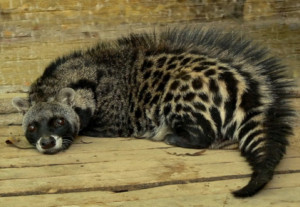
“Civettictis civetta 11” by Николай Усик / https://paradoxusik.livejournal.com/ – Own work. Licensed under CC BY-SA 3.0 via Wikimedia Commons – https://commons.wikimedia.org/wiki/File:Civettictis_civetta_11.jpg#mediaviewer/File:Civettictis_civetta_11.jpg
Nature’s Carnival Trick: The Oryx
Medieval beliefs about animals are fascinating, in no small part because most of the people writing about the strange and fantastic creatures of the world had never seen them. Or anything like them. Also they believed in magic.
That probably explains the brisk trade in oryx horns in medieval England, where they were sold as unicorn horns. The unicorn was viewed as a symbol of purity and grace, and its characteristic spiral horn was thought to have magical properties, cure disease, and detect poisons.
Fortunately for the salesmen, on an oryx you have double the horns to sell.
Nature’s Aristocrats: Vervet Monkeys
Many species of monkey exhibit fascinatingly human traits.
Vervets have developed a seriously entrenched social structure based on who your parents (more specifically your mother) was. They’re like the royal family, except slightly less tolerant of incursions by “commoners.”
In vervet society, the rank of a female is determined entirely by the rank her mother holds. This hierarchy is so strictly adhered to that the baby of a high-ranking female gets preference over adults of an inferior status.
Male monkeys leave the clan to make their own way, and their status is based on strength, age, how long they’ve lived with the group, and alliances they’ve formed.
The ladies, though, are born princesses…or peasants.
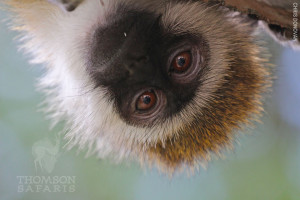 –
–
Nature’s Fashion Model: The Bushbuck
With their willowy legs, natural grace, and of course those massive doe-eyes, it’s only natural that antelope are runway-ready.
But the bushbuck takes it a step (or catwalk) further.
Rather than fighting for mates, male bushbuck prance for them, displaying their unique markings with a special arch-backed, high-stepping walk.
Bushbuck are also capable of living (briefly) off of dew. Now if only they could brew it into coffee and enjoy it with a cigarette, they’d really give the human models a catwalk for their money.
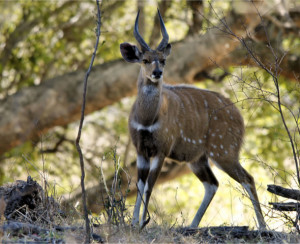
“Tragelaphus scriptus (male)” by © Hans Hillewaert. Licensed under CC BY-SA 4.0 via Wikimedia Commons – https://commons.wikimedia.org/wiki/File:Tragelaphus_scriptus_(male).jpg#mediaviewer/File:Tragelaphus_scriptus_(male).jpg
Nature’s Serial Killer: The Genet
Most carnivores hunt for reasons of survival.
Some, like the genet, seem to kill almost for fun.
Genets are omnivores, eating everything from small mammals to eggs to insects to fruit, but with food they hunt, they are known to be “wasteful” killers; often they’ll eat only the head or breast of an animal.
Of course in the bush, leftovers are readily taken care of. And if you live near a genet, there will be plenty of them to go around…
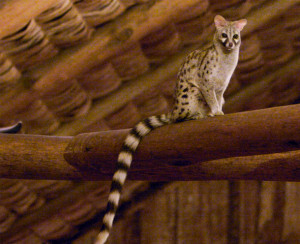
Photo: Thomson Safaris guest, Jon Goulden
Nature’s Expiration Date: The Waterbuck
Sometimes, you’re not sure whether or not you should eat the casserole hidden at the back of your fridge.
And sometimes you can just TELL it has gone off.
Putrefaction is one of the waterbuck’s best defenses from predators; as an animal grows older, secretions from its sweat glands build up, giving the meat a distinct “past its prime” smell that turns predators away.
Of course it probably turns just about everyone else away, too, but that’s a small price to pay for staying off the menu.
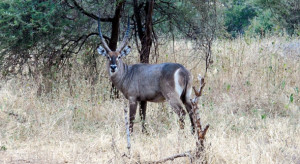
Photo: Thomson Safaris guest, Pam Wear


